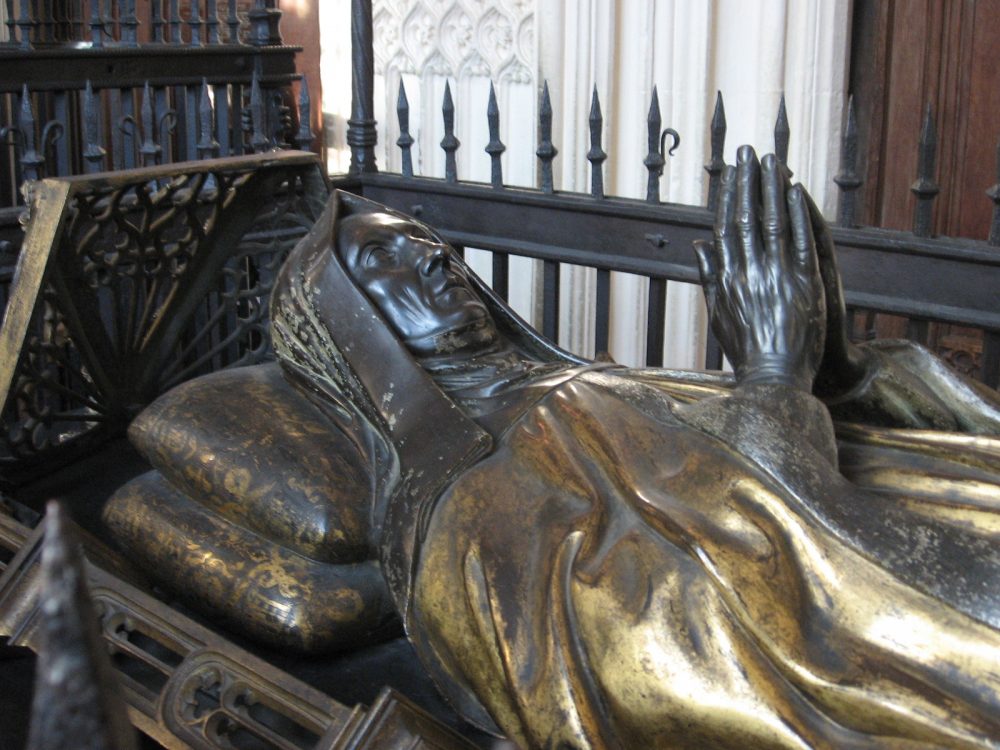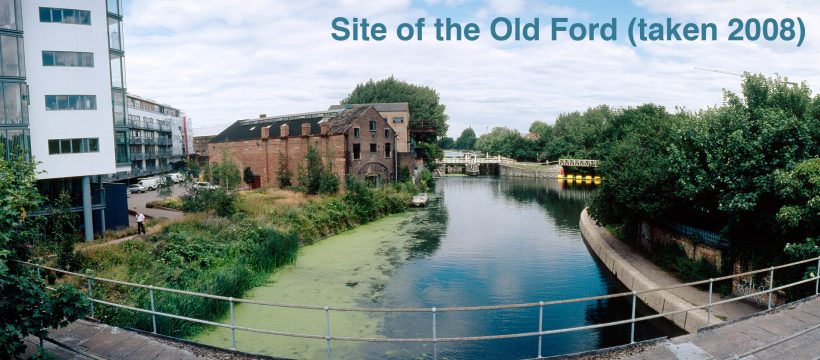The Wars of the Roses were a series of English civil wars which picked up in 1455 and ended with the death of King Richard III in 1485. They’re usually described as being between the supporters of the House of Lancaster (symbol: a red rose), and the House of York (a white rose). The wars were really caused by a number of families brutally fighting for power, land and money. I’ve always thought of the Kings of Old England as running crime families.
When King Edward IV (House of York) died in 1483 he named his brother, Richard, as Lord Protector, and his 12 year-old son as his successor. Richard had his brother’s marriage declared bigamous, locked up his brother’s sons in the Tower, and had himself crowned King of England. Richard III was not too popular.
Lady Margaret Beaufort (Lancaster) was a tough and resourceful woman. You can tell from her tomb in Westminster Abbey (below) just how powerful she was.

In 1455 she married Edmund Tudor. A year later at the age of 13 she had a son, Henry. Her husband had already died after after being captured by the Yorkists. In 1471 young Henry had to flee to Brittany for his own protection. He had a half-blooded claim to the crown, through his mother. But due to the constant fighting, lots of other claimants had been killed.
Fourteen years later Henry Tudor sailed from Honfleur with an army of political dissidents and mercenaries. They landed at Milford Haven. Two weeks later, on 22nd Aug 1485, King Richard III was beaten to death in the Battle of Bosworth Field. Richard had a much bigger army, but Henry’s mother had remarried into the Yorkist Stanley family who were on supposedly on Richard’s side. It’s said that it was Sir William Stanley’s men who killed Richard III. Lady Margaret was married to Sir William’s brother. Two years earlier Henry had agreed to marry Elizabeth of York, daughter of King Edward IV. This marriage cemented Henry’s claim to the throne. It united the Houses of Lancaster and York by marriage, and ended the Wars of the Roses.
On 3rd September 1485 Henry’s battle standards were carried through Shoreditch and the Bishop’s Gate into the City of London. Henry was crowned “Henry, by the Grace of God, King of England and France and Lord of Ireland” on 30th Oct 1485. France was only an ambition.
One of Henry VII’s first acts was to change the date of his coronation in the parliamentary records to the 21st August, the day before the battle. This meant that anybody who had fought against him could be executed as a traitor – if it suited the King. This was the first sign of how the scary Henry Tudor was to keep order throughout his reign.
An old trusted family advisor to Henry’s mother-in-law, Sir Reynold Bray, ran Henry’s tax raising system. He did this by holding tribunals called “The Council Learned in the Law”. This had little to do with the law, and everything to do with shaking down victims. People were summoned to appear before the tribunal thanks to a network of informers, false witnesses in receipt of bribes, and people with scores to settle. Victims had a choice – they could pay a fine and sign a bond agreeing to pay an impossible amount of money; or they could die in jail. By signing the bond their loyalty and good behaviour was assured. Any time the King needed more money he could take everything that they owned.
Bray died in 1503. Henry’s new “debt collectors”, Sir Edmund Dudley and Sir Richard Empson, didn’t even pretend to be doing anything vaguely legal. By now Henry was usually out of sight, increasingly ill with tuberculosis. Henry’s inner circle set about enriching themselves on an enormous scale.
In 1508 the future King Henry VIII’s bodyguard, Sir John Rainsford, decided to do a spot of highway robbery at Old Ford. He held up a convoy of Italian Merchants who were travelling into London. Rainsford stole their consignment of exquisitely detailed, luxurious furniture. There was just one problem, the King had ordered it! Somehow Rainsford was let off. Perhaps this was regarded as normal behaviour at that time. After all, the King himself was what you might call a good operator.
Henry Tudor had started out as a penniless fugitive with a dubious claim to the throne. When he died in 1509 his dynasty was secured, and the cash in his treasury was the envy of every monarch in Europe.
Old Henry’s son, King Henry VIII, promised to be a reformer. His first piece of legislation was a general pardon. It said that normal justice would be resumed, and that the King would be as subject to the law as anybody. Merchants and other traders could now work ‘freely, quietly and peaceably’ with no fear of ‘untrue informations’. The extortion, the repression and the terror had stopped – for a while.
I was recently walking past the National Portrait Gallery and decided to wander in to see what was on. The first picture a came across, just at the top of the escalator, was the beautiful oil painting below of King Henry VII.




Alan, thanks for the reply. V. grateful. I lived in Roman Road as a kid during 1950s-60s and my dad even back then would argue that Roman Road IS an old Roman road and that Old Ford IS the original crossing of the Lea, hence my (armchair) interest in your tale. When I get an chance I’ll follow it up.
Roy, I took copies of some of the old maps in the archives in Bancroft Road. In 1817 the Roman Road is a dotted line marked “Footpath to Clay Hall”, whereas Old Ford Road isn’t named as such, but it is drawn like a road and marked “Lane to Old Ford”. So going back, Old Ford Road was a better route for carts. But obviously not as good as Bow Road which I think used to be called Essex Road, when Essex started the other side of Bow Bridge.
How verified is this? That a river splash across the Lea (at Old Ford) existed since (and maybe before) Roman times is well documented, but Bow Bridge was in existance several centuries before these Italian merchants travelled in to London from Essex so why would they have used a wet ford to cross the river rather than an easier and drier bridge? I do not dispute the story, I can think of several answers to my own query, just wondered if Alan T had researched the story further?
Roy, thanks for taking the trouble to write.
I used various sources for this piece, but it was reading Thomas Pennn’s fascinated and detailed book “The Winter King” which prompted me to write it. That’s where the Old Ford story comes from. The settlement of Old Ford was around the ford itself which was somewhere near where the Greenway crosses the River Lea. It is possible that the furniture was brought by barge from a ship in the Thames to be unloaded at Old Ford. What Thomas Penn says is, “The atmosphere of impunity took curious turns. At Old Ford, near the king’s disease-ridden manor of Wanstead, the prince’s bodyguard Sir John Rainsford turned highwayman. Holding up a convoy of italian merchants travelling into London, he found to his delight a consignment of furniture of exquisite manufacture, which he pillaged…”